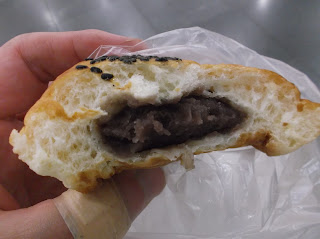As part of supper tonight, I made "dry curry". As I said previously, the term dry curry, as used in Japan, can mean two different dishes: plain rice plus less watery curry and chahan (fried rice) flavored with curry powder. What I mean by dry curry is the former.
Edited to add:
According to Wikipedia, there is also a pilaf type of dry curry.
今日の夕飯にはドライカレーを作りました。前に言ったようにドライカレーとは異なる二つの料理を指します: ご飯と水気の少ないカレーと、カレー粉で味付けしたチャーハン。私が言うドライカレーは前者です。
追記:
Wikipediaによると、ピラフタイプのドライカレーもあるそうです。
The ingredients are:
1 1/2 large onions
4 green peppers
300 g ground pork
100 g eryngii mushroom
3 blocks of store-bought curry roux
Generous amount of raisin
材料は:
玉ねぎ大 1個半
ピーマン 4個
豚ひき肉 300 g
エリンギ 100 g
市販のカレールー 3ブロック
レーズン沢山
I know I should use curry powder instead of curry roux, but I am reluctant to buy curry powder because it's more expensive than curry roux. Besides, there are recipes that call for curry roux.
カレールーではなくカレー粉を使うべきだとは分かっていますが、カレー粉のほうがカレールーより高いので、買う気になりません。それに、カレールーを使ったレシピーもあります。
Edited to add:
I also used 1 small carrot.
I also added 2 tsp instant dashi and some soy sauce.
追記:
にんじん小1本も使いました。
出汁の素を小さじ2杯としょう油を少し入れました。
I bought a pack of nectarines for the first time in this season.
今シーズン初めてネクタリンを1パック買いました。
カレールーではなくカレー粉を使うべきだとは分かっていますが、カレー粉のほうがカレールーより高いので、買う気になりません。それに、カレールーを使ったレシピーもあります。
Edited to add:
I also used 1 small carrot.
I also added 2 tsp instant dashi and some soy sauce.
追記:
にんじん小1本も使いました。
出汁の素を小さじ2杯としょう油を少し入れました。
I bought a pack of nectarines for the first time in this season.
今シーズン初めてネクタリンを1パック買いました。
As I said previously, I think I like nectarines the best of all fruits because they are sweet AND sour.
前にも言った通り、果物の中でネクタリンが一番好きです。甘くて酸っぱいので。
前にも言った通り、果物の中でネクタリンが一番好きです。甘くて酸っぱいので。





















































